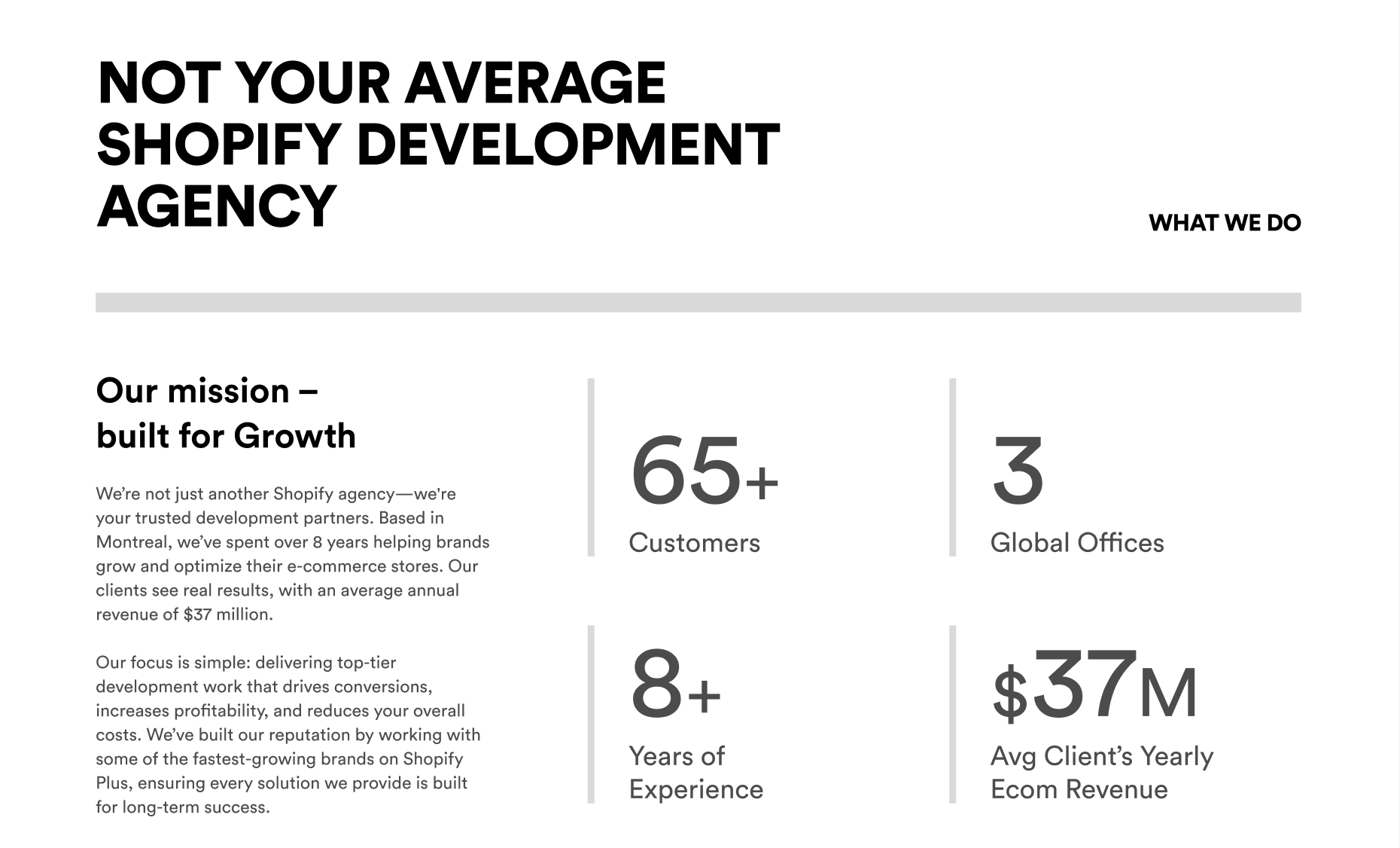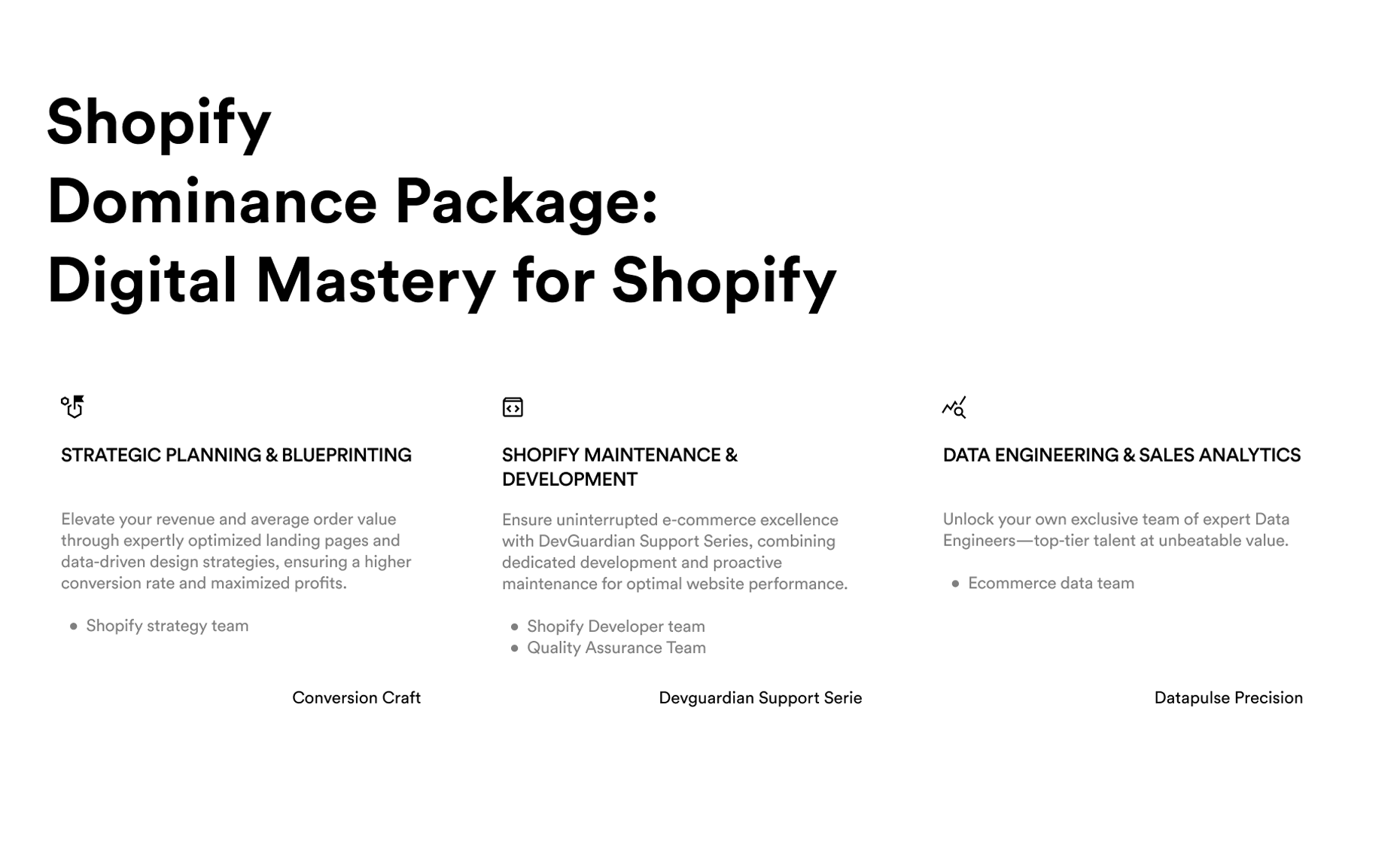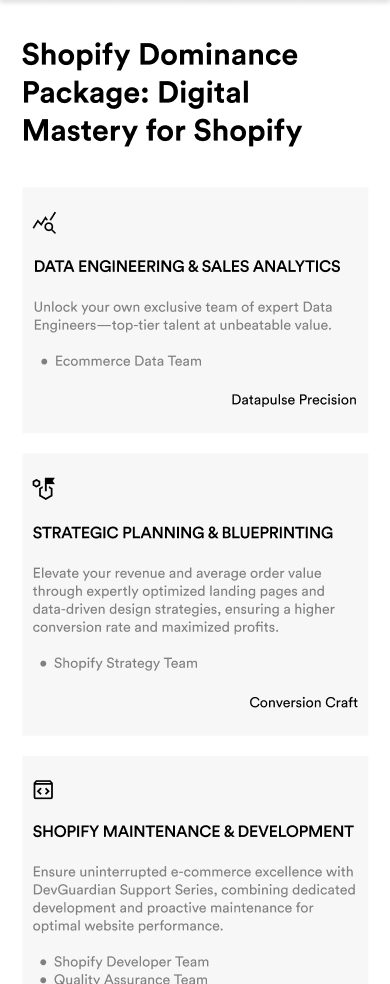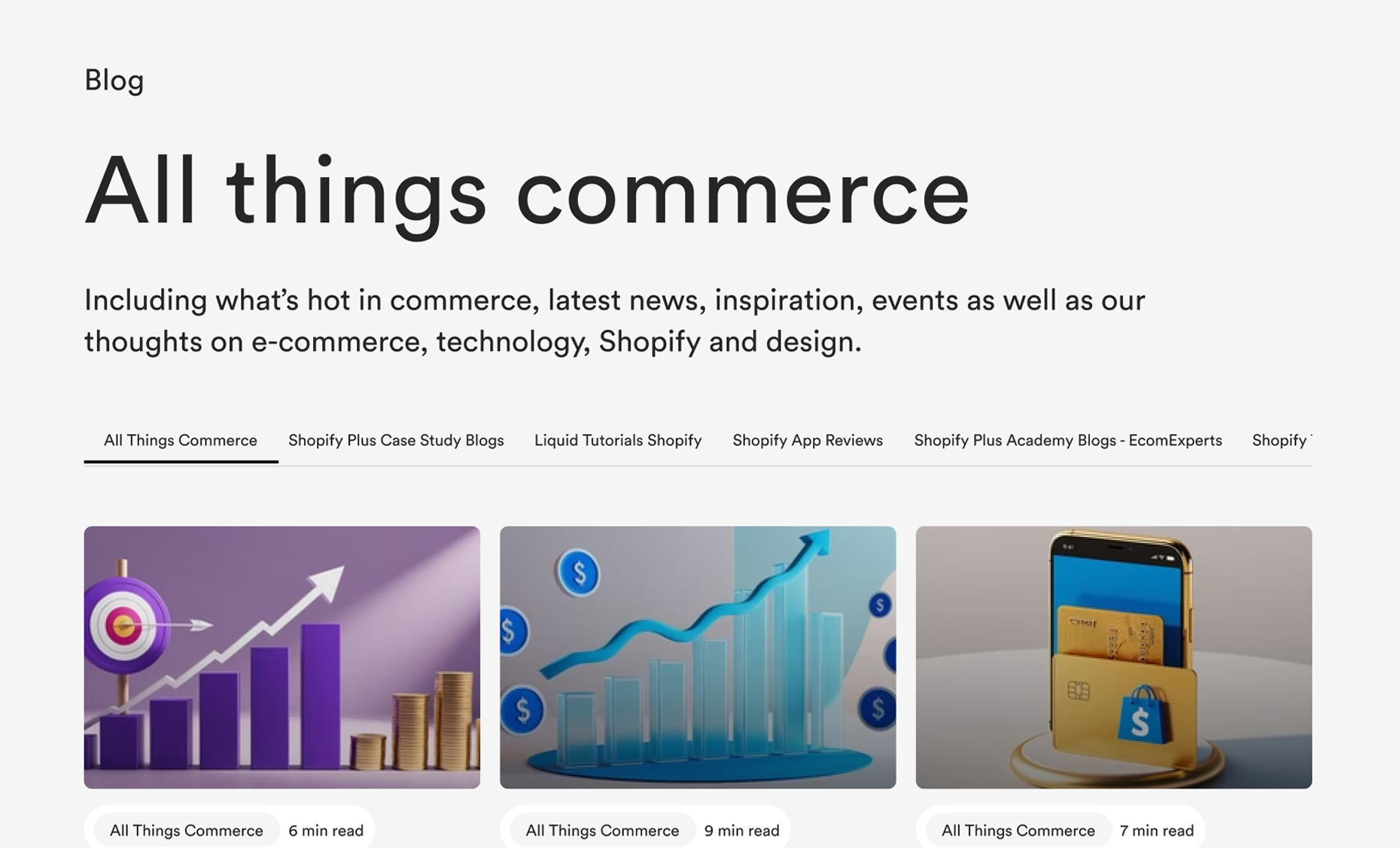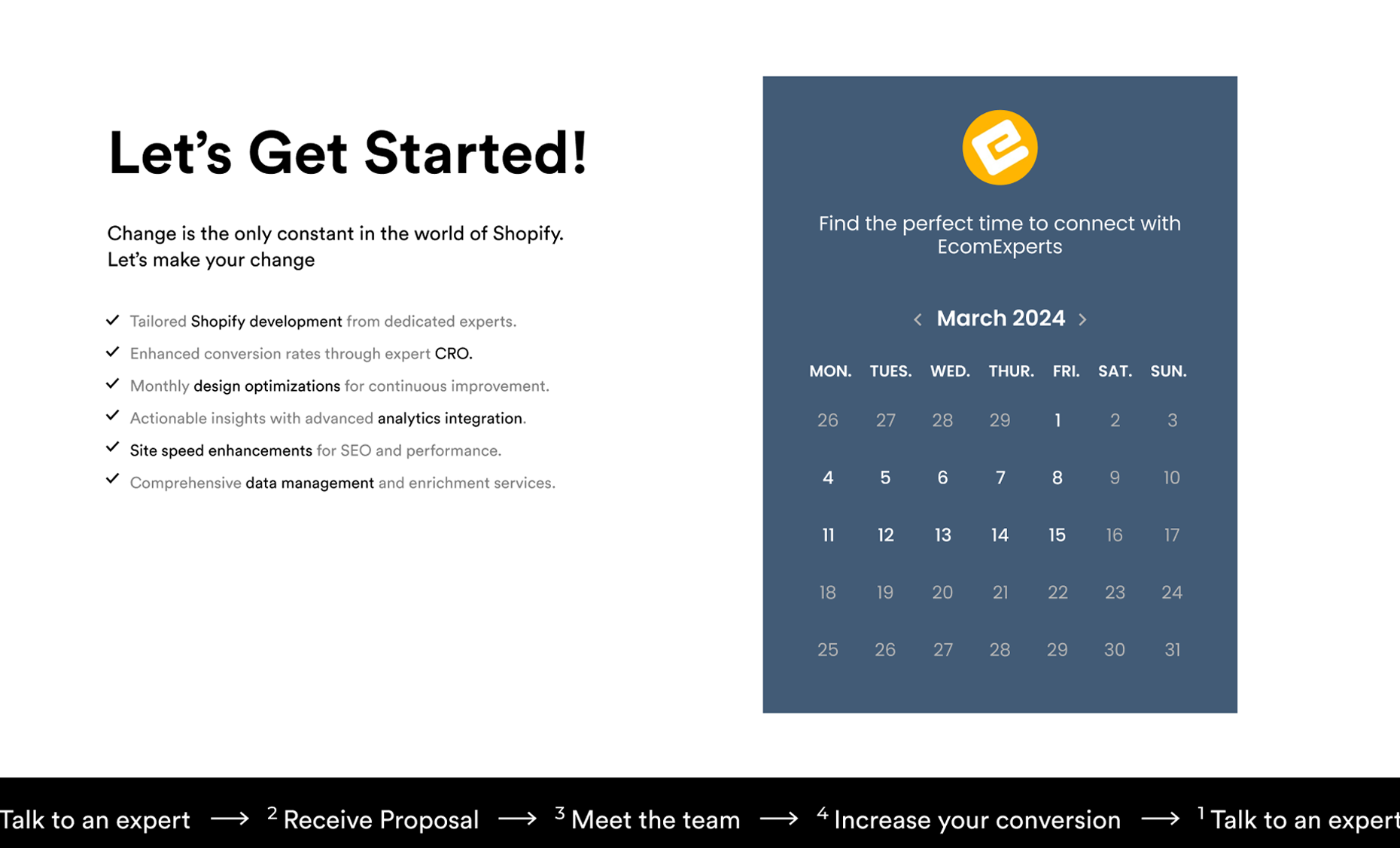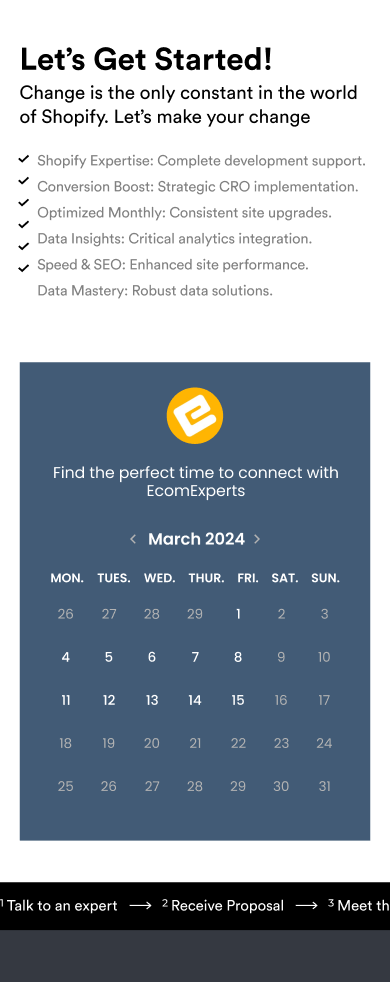Why Building a Shopify Store is a Smart Move Right Now
E-commerce is blowing up, and it’s not slowing down. If you’re thinking about diving in, Shopify is the platform that’s going to get you there fast. Why Shopify? Because it’s the sweet spot between easy and powerful.
Here’s the deal: Whether you’re a total newbie or a seasoned pro, Shopify is built to make your life easier. You don’t need a degree in computer science to set up a killer online store. With drag-and-drop simplicity, you can have a professional-looking store up and running in no time. But if you want to go deeper, Shopify has the tools to let you do just that.
If you’re serious about launching or scaling your online store, Shopify is the way to go. And if you want to ensure your store is optimized from day one, Ecom Experts is here to help you make it happen.
Step 1: Setting Up Your Shopify Account
Signing Up for Shopify
The first step is setting up your Shopify account—this is where it all begins.
1. Getting Started with the Sign-Up Process

Jump over to Shopify’s sign-up page. It’s straightforward—just enter your email, create a password, and choose a name for your store. Once you’re all set, click on “Start free trial.” Shopify gives you 14 days to explore everything without any commitment.
2. Choosing the Right Shopify Plan

Now, it’s time to pick a plan that suits your needs. Shopify offers several options:
- Basic Shopify: Perfect for getting started with all the essentials.
- Shopify: Includes everything in Basic plus enhanced reporting and better shipping rates—ideal for a growing business.
- Advanced Shopify: Offers advanced reporting and lower fees, making it a solid choice for expanding operations.
- Shopify Plus: Built for big operations, Shopify Plus handles high-volume sales and offers custom solutions for scaling.
When choosing your plan, think about where your business is headed. The free trial is a great way to explore, but picking the right plan from the start can give you a head start on your goals.
3. Making the Most of Your Free Trial
During your 14-day free trial, dive into Shopify’s features. Add products, test out themes, and start customizing your store. This trial period is your playground—use it to see if Shopify aligns with your business vision.
And if you need some expert guidance, or want to ensure your store is set up for success right from the start, Ecom Experts can step in to help you maximize your Shopify experience.
Step 2: Choosing and Customizing Your Theme
Once your Shopify account is set up, it’s time to focus on how your store looks and feels. This is where choosing and customizing your theme comes into play—your theme sets the tone for your brand and creates the first impression for your customers. Let’s break it down.
Selecting the Right Theme

Shopify offers over 200 themes in its Theme Store, ranging from free options to premium designs. The key here is to choose a theme that not only looks great but also performs well. Here’s what you need to consider:
- Responsiveness: Your theme needs to look and function perfectly on all devices—desktops, tablets, and smartphones. With mobile commerce growing every day, a responsive design isn’t just a nice-to-have; it’s a must.
- Load Speed: A fast-loading theme is crucial for user experience and SEO. Slow sites drive customers away and hurt your Shopify Speed Score, which can affect your search rankings and conversion rates. Look for themes that are lightweight and optimized for speed.
- Customization Options: While Shopify’s themes are designed to work out-of-the-box, having the flexibility to tweak and adjust your theme to match your brand’s unique style is a big plus. This includes easy access to color schemes, fonts, and layout options.
To start exploring, visit the Shopify Theme Store, where you can filter themes by industry, layout style, and more. Be sure to check out the demo versions of each theme to see how they perform and what customization options are available.
Customizing Your Theme

Once you’ve selected your theme, it’s time to make it yours. Shopify’s built-in theme editor is intuitive and user-friendly, allowing you to customize various aspects of your store without touching a single line of code. Here’s how to get started:
- Uploading Your Logo: A strong brand identity starts with your logo. Head to the theme editor and upload your logo. Make sure it’s high-resolution and fits well within the theme’s designated space.
- Adjusting Color Schemes: Colors play a big role in branding and customer experience. Use Shopify’s color picker to match the theme’s colors to your brand’s palette. This small detail can make a big difference in how your store is perceived.
- Modifying Layout Elements: Shopify themes come with preset layouts, but you can easily rearrange sections to fit your needs. Whether you want to highlight a hero image, showcase products, or tell your brand’s story, drag-and-drop elements in the editor to get the layout just right.
- Adding and Editing Sections: Most Shopify themes allow you to add various sections such as featured products, testimonials, or blog posts. Customize these sections to align with your brand’s messaging and goals.
For those looking to go beyond basic customizations, consider bringing in a Shopify expert developer from Ecom Experts. They can help with advanced coding, integrating custom features, and ensuring your store’s design is not only unique but also optimized for performance.
Step 3: Adding Products to Your Store
Now that your store’s design is coming together, it’s time to fill it with the products you’re excited to sell. Adding products to your Shopify store is more than just listing items—it’s about creating compelling product pages that attract and convert customers.
Creating Product Listings

The first step in adding products to your store is creating detailed and attractive product listings. Here’s how to do it:
- Writing Compelling Product Descriptions: Your product descriptions need to do more than just describe—they need to sell. Keep them clear, concise, and packed with the benefits your product offers. Use persuasive language to highlight what makes your product unique. Remember, you’re not just selling a product; you’re selling a solution to your customer’s problem.
- Uploading High-Quality Images: Visuals are everything in eCommerce. Make sure your product images are high-resolution and show the product from multiple angles. Include lifestyle images if possible—showing your product in action can make a big impact. Don’t forget to optimize these images by adding alt text that includes relevant keywords. This not only helps with accessibility but also boosts your SEO.
- Setting Prices: Pricing is a strategic decision. Make sure your prices reflect the value you’re offering while remaining competitive in your market. Shopify makes it easy to set prices, and you can even add comparison prices to show discounts, which can be a powerful motivator for customers.
- Optimizing for SEO: Don’t skip the SEO on your product pages. Use keywords in your product titles, descriptions, and image alt texts. Write clear, concise descriptions that include relevant keywords without sounding forced. This helps search engines understand what your product is and increases the chances of your page ranking higher in search results.
Organizing Products into Collections

After adding your products, the next step is organizing them into collections. Collections are groups of products that make it easier for customers to browse and find what they’re looking for. Here’s how you can do it:
- Creating Collections: Shopify allows you to create collections based on product type, season, theme, or any other category that makes sense for your store. For example, if you sell clothing, you could create collections for “Summer Wear,” “New Arrivals,” or “Sale Items.” This makes navigation intuitive and improves the overall shopping experience.
- Automating Collections: Shopify gives you the option to automate collections. This means you can set conditions (e.g., product tags, price range) that automatically add products to the relevant collections. This feature saves you time, especially as your inventory grows.
- Promoting Collections on Your Storefront: Once your collections are set up, promote them on your homepage, in navigation menus, or through featured product sections. Highlighting collections can drive more traffic to those specific product groups and help guide customers to the products they’re most interested in.
Step 4: Setting Up Payment and Shipping Options
With your products added and organized, the next critical step is to ensure that your customers can easily pay for their purchases and receive them without a hitch. This involves setting up your payment gateways and configuring your shipping options.
Configuring Payment Gateways

To start accepting payments, you’ll need to set up one or more payment gateways. Shopify makes this process straightforward, offering a range of options that cater to different customer preferences:
- Shopify Payments: This is Shopify’s built-in payment gateway and the simplest option to get started. With Shopify Payments, you can accept all major credit cards directly through your store without the need for third-party accounts. It’s seamlessly integrated, meaning you won’t have to worry about additional transaction fees (beyond the standard credit card rates). Plus, it’s available in multiple countries, making it a versatile choice for many merchants.
- PayPal: PayPal is one of the most popular payment methods globally, and integrating it into your Shopify store is easy. By offering PayPal, you cater to a broad audience, especially those who prefer using digital wallets. Setting up PayPal in Shopify is as simple as linking your PayPal business account to your store.
- Third-Party Payment Gateways: Depending on your location or customer base, you might want to offer additional payment options like Stripe, Square, or even cryptocurrency payments. Shopify supports over 100 payment gateways worldwide, allowing you to choose the ones that best meet your business needs.
Why Multiple Payment Methods Matter: Offering a variety of payment methods can significantly reduce cart abandonment. Different customers have different preferences, and providing multiple options ensures they can pay in the way that’s most convenient for them. This can lead to higher conversion rates and increased customer satisfaction.
Setting Up Shipping Rates
Once your payment gateways are configured, it’s time to set up your shipping options. Shipping is a crucial aspect of your eCommerce business, and getting it right can enhance the customer experience and boost sales.
- Setting Up Shipping Zones: Start by defining your shipping zones—these are the regions where you’ll ship your products. Shopify allows you to set different rates for domestic and international shipping, which can be adjusted based on the specific needs of your business.
-
Choosing Shipping Rates: There are several strategies you can use when setting your shipping rates:
- Flat Rates: Charge a fixed shipping fee for all orders, regardless of weight or destination. This is simple for customers to understand and can be easier to manage.
- Free Shipping: Offering free shipping, especially for orders over a certain amount, can be a powerful incentive for customers. Just make sure to factor shipping costs into your product pricing to maintain your margins.
- Real-Time Carrier Rates: Shopify allows you to display real-time shipping rates from carriers like USPS, FedEx, and UPS. This ensures that your customers are charged accurately based on their order and location.
Optimizing Your Shipping Strategy: The right shipping strategy can make a big difference, especially if you’re selling internationally. Consulting with a Shopify expert developer from Ecom Experts can help you fine-tune your shipping settings, ensuring you offer competitive rates while keeping your costs under control.
Step 5: Launching Your Shopify Store
You’ve done all the groundwork—now it’s time to get your Shopify store live and start making sales. But before you hit that launch button, let’s make sure everything is in place for a smooth, successful launch.
Pre-Launch Checklist
Before you go live, it’s crucial to run through a checklist to ensure your store is fully optimized and ready for customers. Here’s what you need to check off:
- Test the Checkout Process: This is where the money is made, so it needs to be flawless. Go through the entire checkout process as if you were a customer—add products to the cart, apply discount codes, select shipping options, and complete a payment. Make sure everything works smoothly on both desktop and mobile.
- Ensure Mobile Responsiveness: More than half of online shopping is done on mobile devices, so your store needs to look and function perfectly on smaller screens. Double-check that all images load correctly, buttons are easy to tap, and text is readable without zooming in.
- Set Up Google Analytics: To track your store’s performance from day one, set up Google Analytics. This tool provides insights into where your traffic is coming from, how customers are interacting with your site, and which products are performing best. It’s essential for making data-driven decisions as your business grows.
- Check Your Shopify Speed Score: Site speed is a crucial factor in both user experience and SEO. Use Shopify’s built-in tools to check your Shopify Speed Score and make any necessary adjustments to optimize loading times. Remember, a faster site keeps customers happy and boosts your search engine rankings.
- Review Legal Pages: Make sure your legal pages—like Terms of Service, Privacy Policy, and Return Policy—are up-to-date and easily accessible from your site’s footer. These pages build trust with your customers and protect your business.
Going Live
Once you’ve completed your pre-launch checklist, you’re ready to take your Shopify store live. Here’s how to do it:
- Connect a Custom Domain: A custom domain gives your store a professional look and makes it easier for customers to find you. If you haven’t purchased a domain yet, you can buy one directly through Shopify or connect an existing one. Follow Shopify’s domain setup guide to connect your domain to your store.
- Optimize Your SEO Settings: Before launching, take a moment to review your SEO settings. Ensure that your meta titles, descriptions, and URLs are all optimized for your target keywords. This will help your store rank better in search engines right from the start.
- Hit the Launch Button: Once everything is set up and double-checked, it’s time to make your store live. In your Shopify dashboard, navigate to “Preferences” and remove the password protection on your store. Congratulations, you’re officially open for business!
- Announce Your Launch: Don’t forget to tell the world about your new store. Use social media, email newsletters, and any other channels to spread the word. The more people who know about your launch, the better!
Step 6: Marketing Your New Shopify Store
Now that your Shopify store is live, it’s time to get the word out and start driving traffic. Effective marketing is key to growing your customer base and making sales. Here’s how you can leverage social media and implement SEO best practices to boost your store’s visibility.
Leveraging Social Media
Social media is a powerful tool for driving traffic to your Shopify store. Here’s how to make the most of it:
- Choose the Right Platforms: Not all social media platforms are created equal, and not every platform will be right for your brand. Identify where your target audience spends their time. If you’re selling visually appealing products like fashion or home decor, Instagram and Pinterest are musts. For broader reach, Facebook and Twitter can be effective, while TikTok is great for engaging younger audiences.
- Create Engaging Content: Content is king on social media. Share high-quality images, videos, and stories that showcase your products in action. Behind-the-scenes content, customer testimonials, and user-generated content (like customers posting with your products) can also drive engagement. Don’t just post for the sake of it—every piece of content should provide value, entertain, or educate your audience.
- Run Targeted Ad Campaigns: Social media platforms offer robust advertising tools that allow you to target specific demographics, interests, and behaviors. Use Facebook Ads Manager to create campaigns that reach potential customers based on their online activity. Similarly, Instagram and TikTok ads can be used to showcase your products to users who are likely to be interested in them.
- Engage with Your Audience: Social media isn’t just about broadcasting; it’s about building relationships. Respond to comments, messages, and mentions. Show your customers that there’s a real person behind your brand who cares about their experience.
Implementing SEO Best Practices
SEO (Search Engine Optimization) is crucial for getting your Shopify store noticed in search engines like Google. Here’s how to optimize your store:
- Conduct Keyword Research: Start by identifying the keywords your target customers are searching for. Use tools like Google Keyword Planner, Ahrefs, or SEMrush to find relevant keywords with good search volume and low competition. Focus on long-tail keywords that are specific to your products.
- Optimize Your Meta Descriptions and Titles: Each product page should have a unique meta title and description that includes your target keywords. These elements not only help with SEO but also improve click-through rates by providing searchers with a clear idea of what to expect on your page.
- Create High-Quality Content: Content isn’t just for your blog—every product description, category page, and even your homepage should have well-written, keyword-rich content. Ensure that your content answers potential customer questions and includes relevant keywords naturally.
- Optimize Images with Alt Text: Every image on your site should have alt text that describes the image and includes a keyword where appropriate. This improves accessibility and helps search engines understand the content of your images, boosting your SEO.
- Monitor and Adjust: SEO isn’t a set-it-and-forget-it strategy. Use tools like Google Analytics and Google Search Console to monitor your traffic and see how well your keywords are performing. Adjust your strategy based on the data to continually improve your search rankings.
For advanced SEO strategies and to ensure your store ranks higher in search engines, consider consulting with Shopify Experts like Ecom Experts. They can help you implement technical SEO improvements, enhance your content strategy, and optimize your store for long-term growth.
Step 7: Ongoing Maintenance and Optimization
Launching your Shopify store is just the beginning. To keep it running smoothly and growing over time, ongoing maintenance and optimization are essential. This final step focuses on how to monitor your store’s performance and make regular updates to stay competitive.
Monitoring Site Performance
Keeping an eye on your store’s performance is crucial for long-term success. Regularly monitoring key metrics helps you identify areas for improvement and optimize your store for better results. Here’s how to do it:
- Using Google Analytics: Google Analytics is a powerful tool that tracks a wide range of metrics, from traffic sources to user behavior on your site. Set up Google Analytics to monitor how visitors are finding your store, which pages they’re spending the most time on, and where they might be dropping off. This data is invaluable for making informed decisions about where to focus your efforts.
- Leveraging Shopify’s Built-In Analytics: Shopify offers built-in analytics that provide insights specific to eCommerce, such as sales reports, customer behavior, and product performance. You can track your Shopify Speed Score and other critical metrics right from your Shopify dashboard. Regularly reviewing these analytics will help you spot trends, identify high-performing products, and understand customer behavior.
- Monitoring Site Speed: A fast-loading website is crucial for both user experience and SEO. Use tools like Google PageSpeed Insights and Shopify’s speed optimization features to regularly check your site’s speed. A high Shopify Speed Score not only improves customer satisfaction but also helps boost your search engine rankings.
Regular Updates and Improvements
A successful online store isn’t static—it evolves with trends, customer preferences, and technological advancements. Regular updates and optimizations are necessary to keep your store competitive and engaging.
- Updating Your Store’s Design: Trends change, and so should your store’s design. Regularly review your store’s layout, colors, and images to ensure they stay fresh and aligned with current design trends. This keeps your store looking modern and appealing to customers.
- Refreshing Product Offerings: Keep your product catalog updated by adding new items, retiring slow movers, and updating product descriptions and images. Regularly introducing new products can attract repeat customers and keep your store dynamic.
- Optimizing Marketing Strategies: As your store grows, your marketing strategies should evolve too. Experiment with new social media platforms, refine your SEO tactics, and explore different types of promotions and ad campaigns. Monitoring the results will help you understand what works best for your audience.
- Ongoing Support and Optimization: As your store grows, the need for advanced customizations and optimizations will increase. This is where Shopify Experts like Ecom Experts come in. Whether you need help with a major redesign, custom development, or advanced SEO strategies, consulting with an Expert Shopify Developer ensures that your store remains competitive and continues to grow.
Conclusion
Recap of Key Steps
Building a successful Shopify store from scratch is a journey, but you’ve now got the roadmap. From setting up your account and selecting the right theme to adding products, configuring payments, and launching your store, each step is critical to your online success. Remember, your Shopify store isn’t just a one-time setup—it requires ongoing maintenance, optimization, and attention to detail.
Whether it’s monitoring your Shopify Speed Score to ensure fast load times or regularly updating your product offerings, these continuous efforts are what will set your store apart and keep it thriving.
For those ready to scale their business, Shopify Plus offers robust tools to handle growth, and bringing in professional support can make all the difference. Whether you need advanced customizations or help optimizing your store, having experts on your side is invaluable.
FAQs
Q1. How do I start building a Shopify store from scratch?
A1. To start building your Shopify store, you need to create an account on Shopify, select a plan that suits your business needs, and set up your store’s basic structure. This includes choosing a theme, adding products, configuring payment gateways, and setting up shipping options. Once everything is ready, you can launch your Shopify store and begin selling online.
Q2. What is the best way to choose a Shopify theme?
A2. When choosing a Shopify theme, focus on finding a design that is responsive, fast-loading, and easy to customize. The Shopify Theme Store offers over 200 themes to choose from, so select one that aligns with your brand and product offerings. Prioritize themes that enhance user experience and support SEO best practices.
Q3. How can I optimize my Shopify store’s speed?
To optimize your Shopify store’s speed, focus on choosing a lightweight theme, compressing images, minimizing the use of apps, and using Shopify’s built-in speed optimization tools. Regularly monitor your Shopify Speed Score to ensure your site loads quickly, which is crucial for both user experience and search engine rankings.
Q4. What payment gateways should I use for my Shopify store?
Shopify offers various payment gateways, including Shopify Payments, PayPal, and third-party providers like Stripe. It’s essential to offer multiple payment options to cater to different customer preferences and reduce cart abandonment. Shopify Payments is a popular choice for its seamless integration and no additional transaction fees.
Q5. How can Ecom Experts help optimize my Shopify store?
Ecom Experts can assist with advanced customizations, technical SEO, speed optimization, and ongoing maintenance of your Shopify store. Whether you’re looking to scale your business or need help with specific technical challenges, consulting with a Shopify expert developer from Ecom Experts can provide the professional support needed to keep your store competitive.




